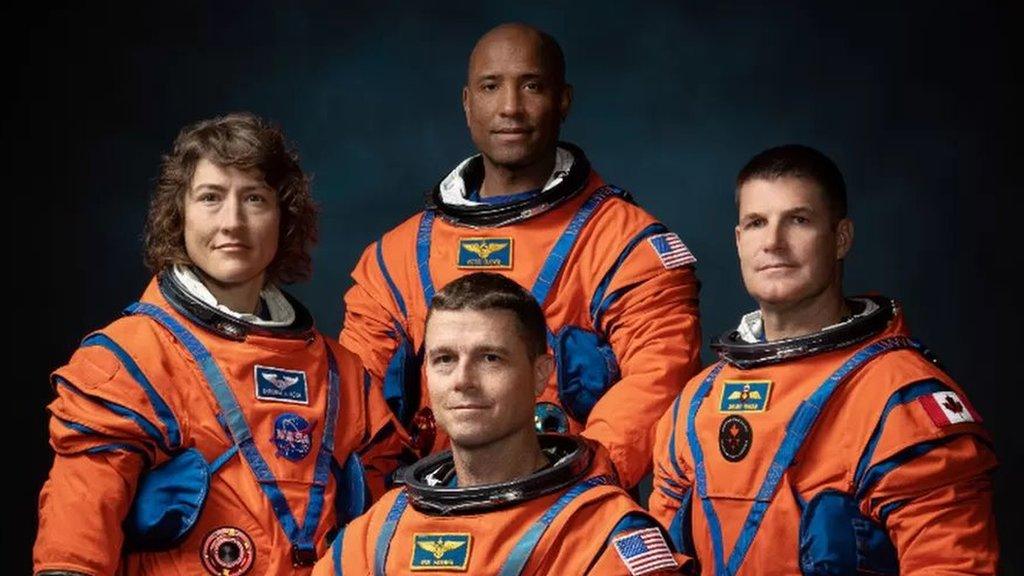Artemis II: The crew for first Moon mission in 50 years has been announced
- Published
- comments

These four astronauts will be the crew for the Artemis 2 mission
Nasa has announced the crew that will be going on the first Moon mission in more than 50 years.
American astronauts Christina Koch, Victor Glover and Reid Wiseman and Canadian astronaut Jeremy Hansen have been selected for the much anticipated mission which is due to take place next year.
Known as Artemis II, it'll involve the astronauts travelling around the Moon, testing the route that will be taken on future missions.
"Among the crew are the first woman, first person of colour, and first Canadian on a lunar mission, and all four astronauts will represent the best of humanity as they explore for the benefit of all," said Vanessa Wyche, the director of Nasa's Johnson Space Flight Centre.
Although the astronauts won't be setting foot on the Moon, their important space trip will pave the way for a eventual lunar landing.
The team will now begin a period of intense training to get themselves ready.
What do we know about the Artemis II crew?
Reid Wiseman (left), Christina Koch (left-centre), Victor Glover (right-centre) and Jeremy Hansen (right) could be heading to space late next year
Reid Wiseman will be the mission's commander. He's a US Navy pilot who has also previously served as the head of Nasa's astronaut office. He's flown one previous mission to the International Space Station (ISS) back in 2015.
American astronaut Christina Koch is the only woman on the mission. She's an electrical engineer with a pretty impressive track record, having spent more time in space than any other woman.
In 2019 she made the first all-female spacewalk along with fellow astronaut Jessica Meir.
US Navy test pilot Victor Glover is the third member of the Artemis II team. He joined Nasa in 2013 and made his first spaceflight in 2020. He was the first African American to stay on the space station for an extended period of six months.
Jeremy Hanson is the chosen Canadian astronaut on the team. He was a fighter pilot with the Royal Canadian Air Force before joining the Canadian Space Agency and he's yet to travel to space.
What are the Artemis Moon missions?
Artemis is a three-part series of increasingly complex missions aimed at putting a man and a woman on the Moon before the end of 2025.
The Artemis I mission didn't have any astronauts on board (although Shaun the sheep went) but was designed to fully test the Moon mission kit - was successfully sent in orbit around the Moon in November 2022.
The Artemis II mission is expected to blast off in November 2024 at the earliest - with this crew on board - and will circle around the Moon and return home.
Artemis III will land astronauts on the Moon for the first time since the Apollo missions of the last century
What was the Apollo Space Program?
This picture shows the Saturn 5, Nasa's Moon rocket in the 1960s, launching
In 1962, the then US President John F Kennedy announced a big ambition in a speech where he said: "We choose to go to the Moon!"
It was during a period known as the Cold War, a time of tension between the United States and the Soviet Union - which was a group of countries led by Russia.
Both nations were competing to have more advanced technology and sending people into space was part of that, it was known as the 'Space Race'.
WATCH: What was the space race? (October 2017)
US space agency Nasa invested lots of money in Apollo aiming to land humans on the Moon and bring them safely back to Earth.
On the morning of 20 July 1969, astronauts Buzz Aldrin, Neil Armstrong and Michael Collins the crew of Apollo 11, made it to the Moon's surface.
Astronaut Neil Armstrong became the first man to step out onto the lunar surface.
As he made the famous footstep, he said: "That's one small step for man, one giant leap for mankind."
Sending people to the Moon is expensive, and although there were several other Moon missions after Apollo 11, in 1972, Apollo 17 was the last.
Today, private Space companies, such as Space X mean that the US government doesn't have to cover all of the costs, SpaceX's Starship is scheduled to land Artemis 3 astronauts onto the Moon's surface potentially by 2025.
A crewed mission to the Moon is planned to land on the lunar surface no sooner than 2025
Despite Nasa sending people to the Moon over 50 years ago, the Artemis missions will still have some firsts; including sending the first woman and first person of colour to the lunar surface.
If the Artemis missions are successful, the long term aim is to build a human base on the Moon that will operate for many years to come.
- Published4 September 2022
- Published16 July
- Published16 July 2019
